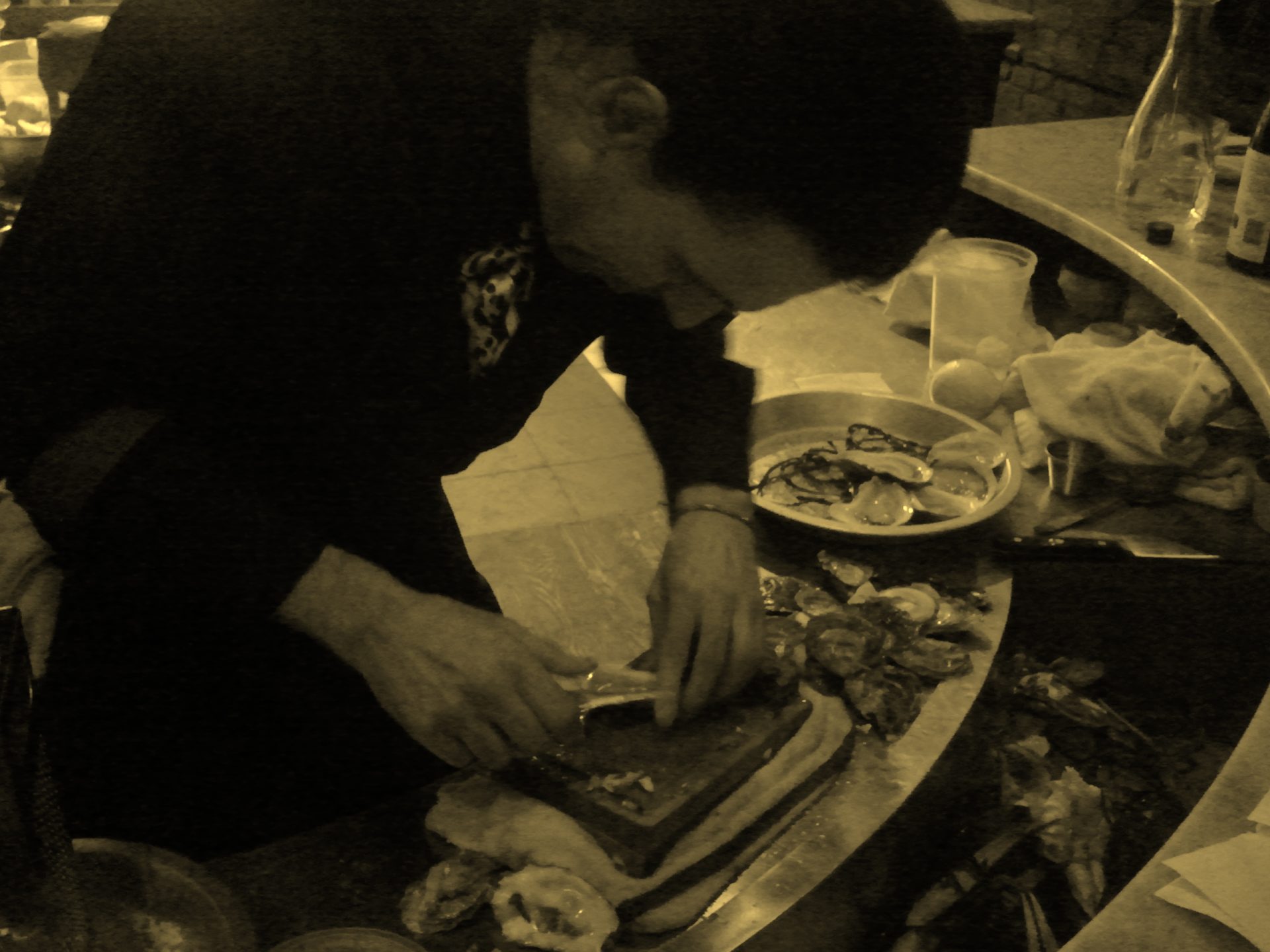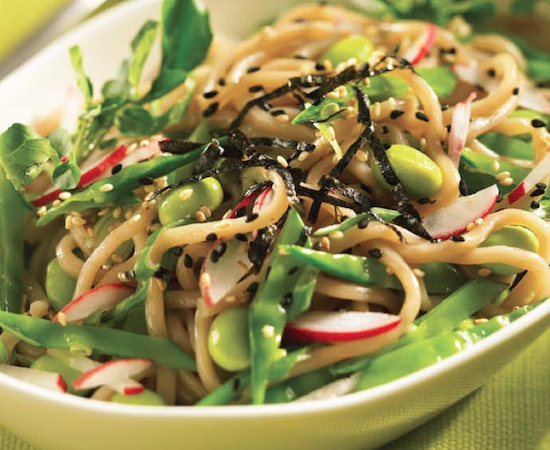by Anthony Wing

ENTER
I need to pick up oysters. But in this large city on a beautiful sullied lake, the chances for locating the best shellfish increase the further one moves from the water. So I will visit the Oyster Boy walk-in refrigerator, where Toronto’s premium product resides, purchase a box and move it two blocks to a bistro fridge to await procession and grandeur.
I am a veteran oyster shucker, mandarin virtuoso of an unnatural act but cursed withal to carry a title unequal to the romance and horror of the task. The term is generally met with the low comedy of cheap rhyme and idiom: wherever I have retooled a restaurant oyster program, potent notables in transit are duly handed a Sharpie and invited to inscribe as they wish for a Shell of Fame wall; my heart circles the drain when I’m reminded of the majority of signatories who choose “aw shucks and “”shucking great” variants. The moment a shucker steps onto an ice bay stage he flirts with confinement as if trapped in a comedy club for a night of career-killing performances. Worse, my cell phone will not form the word “shucker”, defaulting instead to manual input. But we press on with the honorific, which after all may be the least of our deformities.
SNAP
Everything behind me is alive. This principal imbalance surfaces every night by the ice bay: I am harvesting before you a product very much alive before I retrieve it and not quite dead when I drop it on crushed ice and set it forth. I have often tried “…but everything in front of me is delicious!” but it is just another obstacle for celebrants of the most romantic of connections between humans and the ocean. Holding a triplicate role on one stage, a shucker out in the maelstrom of guest interaction must play, alternately and simul, shrink, cleric and executioner in the run of each performance. A successful night will entrain fear management, a proselytizing spirit and, most bizarre, accelerated murder.
Here an appropriate thought experiment would be to imagine oneself seated at a chef’s table in an abattoir where jaunty killing floor staff sport neckties and black aprons. But oyster shuckers are at least slightly better positioned in a conservational sense: an employee at one of Canada’s largest slaughterhouses once stumped me by asking which part of the cow was discarded; after several misses he revealed the unused component as “the ear we tag.” Not so the bivalve: calcified and splendidly recyclable, everything not consumed can be diverted.
CUT
Dedicated shuckers are not thick on the ground in the foodservice industry. Most often it is considered a means to an end by practitioners and a usefully idiotic employee landfill by chefs; shuckers are either angling for bartending duty or banished from kitchen service after striking out at breakfast prep. My own crooked trail is different. In common with the two dozen or so people like me in Canada I arrived from intensive catering experience preceded by an inexplicable oysterward push: mine was in the form of a box of standard Malpeques whose contents I was instructed to divert for oyster meat. I finished the task and nipped over to a hospital for a tetanus shot, returning the next day somewhat differently determined. So for me the oyster conduced to a long spell of benign madness, but the roots of bivalve determination are even more unclear. Perhaps it was bad imago mojo: would-be heroes were too often observed in the act of destroying without revelation nor reason nor beauty: Cookie Monster peaking in a tizzic frenzy and smashing to pieces his prize against his face, Townshend and Hendrix’ guitar smashing and fiery genuflections, Glenn Gould befouling original scores with his own arrangements, and so forth unto the abysm. I sought a more musical butchery on a narrower stage, guessing that restrictions could be portals to a raging creativity.
I get on the streetcar to Oyster Boy, my trade tools riding along in an MD bag. The principal difference between oyster knives and prison shanks is that the former are generally sharper and more sinister-looking. To maintain the knife edge I visit a 2-wheel grinder twice monthly, whetting the appetites of danger; more than once this monomaniacal carry-on routine has not played well at airports. Along with the knives are two arm braces, one for backup when the Velcro invariably sags. No romantic relationship is free of repetitive strain. On this matter my oyster seminars often feature useful advice: if you have a question at an oyster bar, look for the guy with a gammy elbow.
Central to my seminars is the demonstration of a 5-step process to a cleanly shucked oyster: Enter, Snap, Cut, Spin and Finish. But in yet another inversion, shuckers at the magus level of 1000 or more pieces per night are in a far more dangerous position than their domestic kitchen counterparts despite dearly bought bivalve grandmaster norms. In the tactical flurry from bay to plate to table, the air is thicker with demand and resolution; when a screamingly sharp knifetip darts with force in a tiny space on snowflake-dissimilar targets, the slightest mechanical disruption can result in a far more emergent injury than could ever befall a beginner. Moreover, shuckers in busy restaurant or catering situations are alienated from intended and perceived ends: knives fly blind in search of the upper adductor muscle, which is somewhere near 2/3 down the shell from the entry mantle. Shucking is a presumptive knife skill, which isn’t welcome news for considerations of workplace safety.
SPIN
But I chose this path and I walk it in boots of love and blood. I turned away from the professional kitchen and its casual forgeries, fascinated for a time viewing chefs as ice sculptors whose work rises and vanishes as day to night but ultimately opting for a raw satellite and serviceable riddle: not quite kitchen and not quite bar, just as the oyster can’t seem to settle on a gender.
Often the bivalve will begin life male, flip to female and even return to male. In the adrenal heat and flash of a dinner service there is gender dissolution in my heart and head as I move in a half-crouch, spinning to the ice bay and back, pausing to juggle lemons or ferry plates to tables to track between consumers and cringers. But the heat rises, and now with eight orders before me in familiar multiples of six and twelve, zonal laws are passed unamended and enforced afresh. Immersive and febrile, the infinitude of moments stuck in the on position, I know only the sight of voices all about me and the sound of gunmetal grey and sepia flesh bodying into view. Here I am a goddess’ nightmare of mortality, an earthen Kali with a belt of severed adductor muscles and pearlmother necklace, Myshkin willful and self-aware, a barking star in a constellation of the living and the shucked. Here as shells fall at my side and the splash rose on my apron bounces free, my head often spins with mantic replays of the Beethoven 111, Holidays in the Sun and the Dies Irae chant with its million rips and insertions into massive sectional libraries of music. Here I kill in love.
FINISH
I have about an hour to sign off, deliver the box safely to tomorrow’s location and make it to my regular oyster shift in the other direction across downtown Toronto. I arrive at Oyster Boy, now open for Saturday business at the sleepy 3 pm prep time. A pint of Guinness is placed before me and I fare-fish through my pockets while scanning the chalkboard. As a founding team member of a decade past, I am allowed solo entry for product inspection. I descend the dodgy steps and head for the fridge, a 20,000-piece capacity unit. As I push the door shut behind me an amalgam of five different Maritime selections delivers a brackish blast of turbulence and flavour.
I stop cold, in sense-memory yet colder, chest heaving, palms catching my knees, reminded suddenly and again why I bend double in this room and dozens like it across Canada, why I haunt oyster farms and factories at the high noon and midnight illumining hours and return to construct low-tide beach replicas of wood and seaweed in the city’s restaurants, why I consigned my elbow to a debilitating uncertainty and yet night after night stand transfixed nearby as barriers dissolve for twitchy guests lifting shells to lips for the first time.
They make me cry.
 Anthony Wing is a writer, oyster celebrant, pianist, composer-arranger and Shakespearean anti-fascist. He performs at Baron Rouge Sunday brunch and Monday evenings at Union, 72 Ossington Avenue, Toronto, Ontario, Canada.
Anthony Wing is a writer, oyster celebrant, pianist, composer-arranger and Shakespearean anti-fascist. He performs at Baron Rouge Sunday brunch and Monday evenings at Union, 72 Ossington Avenue, Toronto, Ontario, Canada.








such an interesting article Anthony, i look forward to your next installation!
Absolutely riveting. Hope to read more from you in the future!
This is a masterpiece, in the same vein that Finnegan’s Wake is- IE: barely readable.
Here I am thinking I know most things there is to know about those Tantalizing little bi-valves. But once again Mr. Wing has raised ones knowledge on a given subject.
AnywayS good artical.
Seriously, you call this writing? This SHUCKS!
My favourite part was when he described his life shucking oysters!
From oy to joy – you knocked it outta the park, baby.
I think you are a real, and special person, great read brother
Orwell would be proud! Skills worthy of a Debrouillard…
Spoken like a true bonfide oyster shucker. Thanks Anthony. You write and shuck with a very romantic heart and soul
Thank you Anthony. I am reading it over and over. The Herman Melville of Oysters you are! Its only gonna get better(and worse). You know what I mean. Great description of our trade!
cool article Anthony – stay in touch
When does the musical come out? You know, “Hello Good Bi-Valve” ?
I wept openly.
Thank you for your kind and thoughtful posts.Stay tuned for more oyster dispatches and we’ll see you at Union in the meantime.
Drama, tension, heart–it has everything you need to be moved by a great story. Plus, I learned something.
I’ve never had oysters. Are they any good?
Who’d’a thunk there was so much pearly beauty to be expressed about living amongst these oysterly bivalves you find yourself sharing the stage with…
the piece invites ‘come-around-and-have-a-look-see’ at the source of such passion.